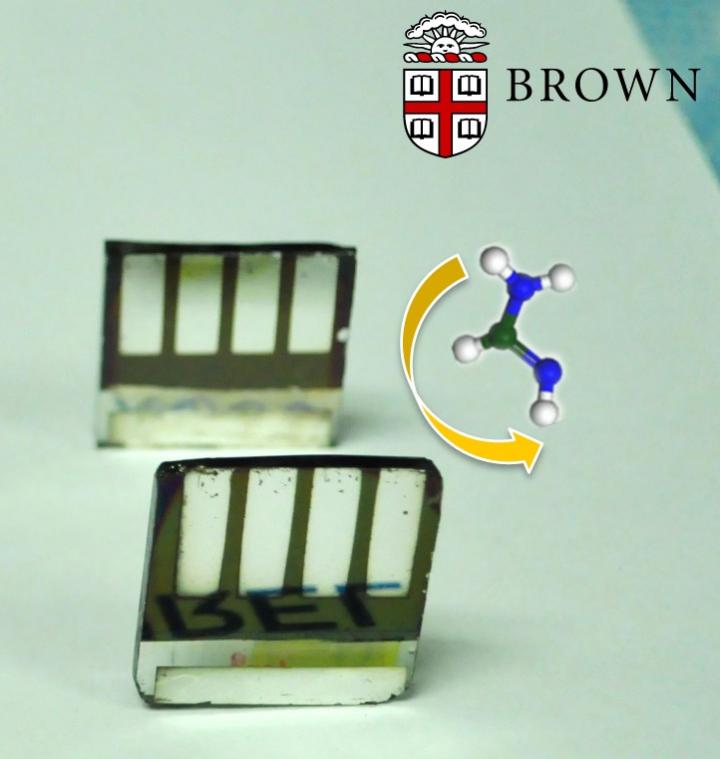
[Image above] Credit: Iamdogjunkie; Flickr CC BY 2.0
Editor’s note: This story originally appeared in print in the June/July 2016 ACerS Bulletin.
Perovskite solar cells have been making news for their great potential for high efficiency and low cost—but the research continues in order to scale up this technology for wide-range applications.
Last month at ACerS Materials Challenges in Alternative and Renewable Energy (MCARE) conference in Clearwater, Fla., Md. K. Nazeeruddin (Swiss Federal Institute of Technology Lausanne, Switzerland) presented his research about perovskite solar cells and the challenges associated with developing them for efficient solar energy storage.
“Stability is the biggest problem with perovskites and we have to come up with solutions,” Nazeeruddin says.
Organic–inorganic hybrid perovskite materials are very attractive because, when stable, they are powerful solar light harvesters, explains Nazeeruddin.
Stateside, a team led by Brown University researchers was awarded $4 million last summer by the National Science Foundation to study the potential of perovskite solar cells.
“Perovskites have great promise for use in a variety of highly efficient, low-cost solar cells,” ACerS member Nitin Padture, professor in the School of Engineering and director of Brown’s Institute for Molecular and Nanoscale Innovation, said last year about the research. “We want to understand better the basic science behind these solar cells, look for ways to develop new technologies based on that understanding, and investigate scalable production methods that could one day bring perovskite solar cells to market.”
Nearly eight months later, Padture and his team—in collaboration with the National Renewable Energy Laboratory (NREL) and the Chinese Academy of Sciences’ Qingdao Institute of Bioenergy and Bioprocess Technology—are getting closer to making perovskite solar cells a mass-market reality.
“We’ve demonstrated a new procedure for making solar cells that can be more stable at moderate temperatures than the perovskite solar cells that most people are making currently,” Padture says in a Brown University news release about his team’s latest research. “The technique is simple and has the potential to be scaled up, which overcomes a real bottleneck in perovskite research at the moment.”
Perovskites can go head-to-head with traditional silicon solar cells when it comes to how efficiently they convert sunlight into energy, the release explains. But where perovskites have the leg-up is the fact that they’re potentially much cheaper to produce than their silicon rivals and can be made partially transparent for use in windows and skylights for power generation.
Some researchers are even taking the “better together” approach and say perovskites paired with silicon could create higher-efficiency solar cells.
Although researchers are taking different approaches to studying perovskites, they all face the same main hurdle in regards to scalability—perovskites are known for their lacking thermal stability.
As the Brown University release explains, most of the perovskite solar cells produced today are made with of a type of perovskite called methylammonium lead triiodide (MAPbI3). But MAPbI3 tends to degrade even at moderate temperatures.
“Solar cells need to operate at temperatures up to 85ºC,” Yuanyuan Zhou, a graduate student at Brown who led the new research, says in the release. “MAPbI3 degrades quite easily at those temperatures.”
That just can’t beat the heat in solar panels that need to stand the test of time and wear-and-tear.
As an alternative, there’s been growing interest in solar cells that use a type of perovskite called formamidinium lead triiodide (FAPbI3) because it’s more thermally stable than MAPbI3, the release explains.
But FAPbI3 perovskites present their own challenges. They’re harder to make than MAPbI3 even at laboratory scale, Padture says, let alone making them large enough for commercial applications.
Part of the problem is that formamidinium has a different molecular shape than methylammonium. So as FAPbI3 crystals grow, they often lose the perovskite structure that is critical to absorbing light efficiently, the release explains.
With this in mind, the team made high-quality MAPbI3 thin films using gas-based techniques they had developed over the past year to make perovskites. Then they exposed those MAPbI3 thin films to formamidine gas at 150ºC. The result? The material instantly converted from MAPbI3 to FAPbI3 while maintaining the crucial microstructure and morphology of the original thin film needed for efficient light absorption.

An international team of researchers has shown a way of flipping a chemical switch that converts one type of perovskite into another: a type that has better thermal stability and is a better light absorber. Credit: Padture Lab; Brown University
“It’s like flipping a switch,” Padture says. “The gas pulls out the methylammonium from the crystal structure and stuffs in the formamidinium, and it does so without changing the morphology. We’re taking advantage of a lot of experience in making excellent quality MAPbI3 thin films and simply converting them to FAPbI3 thin films while maintaining that excellent quality.”
Laboratory-scale perovskite solar cells made using this new method showed efficiency of around 18%—rather close to the 20–25% achieved by silicon solar cells, the researchers found.
This ability to switch from MAPbI3 to FAPbI3 marks another potentially useful step toward scaling up perovskite solar cell technology, the researchers say.
“The simplicity and the potential scalability of this method was inspired by our previous work on gas-based processing of MAPbI3 thin films, and now we can make high-efficiency FAPbI3-based perovskite solar cells that can be thermally more stable,” Zhou adds. “That’s important for bringing perovskite solar cells to the market.”
The research, published in the Journal of the American Chemical Society, is “Exceptional morphology-preserving evolution of formamidinium lead triiodide perovskite thin films via organic-cation displacement” (DOI: 10.1021/jacs.6b02787).
